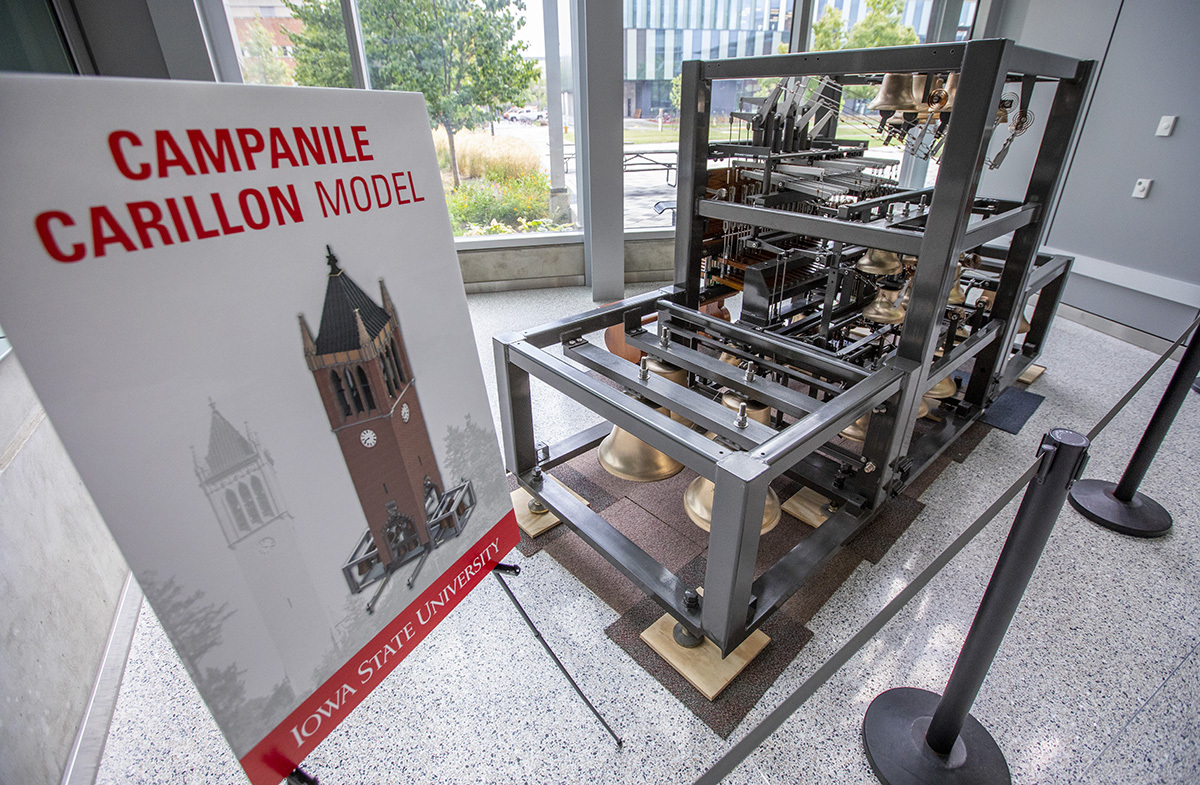Fall enrollment of 31,825 shows strong retention
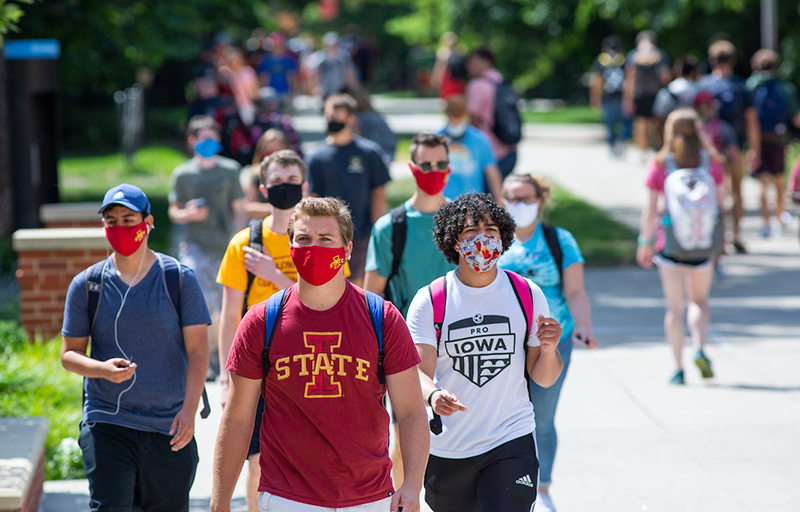
Students head to class on the first day of the semester, Aug. 17. Photo by Christopher Gannon.
Iowa State's one-year retention rate set a record this fall with 88.5% of first-year students returning for a second year. President Wendy Wintersteen says the retention rate is a testament to Iowa State’s commitment to students.
"Last year's first-year students didn't have a typical experience with the transition to virtual instruction after spring break," Wintersteen said. "The fact that these students are returning in record numbers shows their resiliency. It also reflects the work of so many faculty and staff on campus to support students by providing flexibility in courses and support services."
Record student success
Iowa State's fall enrollment of 31,825 students includes a diverse and academically strong class of 5,071 first-year students with a record GPA of 3.71 and 17.2% U.S. multicultural students. Laura Doering, associate vice president for enrollment management, says research has shown that high school GPA is the best indicator of college completion at Iowa State.
"We are extremely pleased to see year-over-year increases in GPA in our first-year students," Doering said.
The university also set a record of 74.7% for the six-year graduation rate, a federal standard set by the U.S. Department of Education, and Iowa State outperforms the national average by 20%. The average Iowa State student takes 4.4 years to complete their degree.
Overall, enrollment is down 1,566 students from last year, but Doering says this was expected due to the COVID-19 pandemic, immigration challenges and changes in Iowa's demographics.
Support for international students
Iowa State offers more than 90 learning communities and created a new one this fall for first-year international students who could not enter the country to attend classes on campus. The International Adventure learning community provides a 100% virtual experience for new international students to take common courses, connect with one another, receive support from peer mentors and explore career options from anywhere around the world. There are four options available: business, computer science, engineering and general education for students of all majors.
Fall 2020 enrollment by college
|
Agriculture and Life Sciences |
4,534 |
|
Business |
4,713 |
|
Design |
1,890 |
|
Engineering |
8,098 |
|
Human Sciences |
4,001 |
|
Liberal Arts and Sciences |
7,494 |
|
Veterinary Medicine |
787 |
|
Interdepartmental units and graduate undeclared |
308 |
Targeted COVID testing strategy is doing its job
Iowa State's COVID-19 targeted testing strategy and contact tracing is working to find the positive cases in the university community -- and protect the rest, Dr. Alex Ramirez said during an Aug. 31 town hall among senior leaders and employees. Ramirez, assistant dean for academic and student affairs in the College of Veterinary Medicine and an infectious disease specialist, is serving this fall on the university response team and as adviser to the COVID-19 public health team.
Since classes started, Iowa State's strategy has been to identify positive cases and isolate them from the general population, so those being tested at the Thielen Student Health Center either show symptoms or were exposed to a confirmed positive case. It's a group you'd expect to test positive often, he said. In fact, the percentage of positive test cases conducted at the center was 13.6% in the first week of class and nearly 29% in the second week.
Second campus test site
Johnny's (east side of Hilton Coliseum)
- Starting Tuesday, Sept. 8
- Monday-Friday 10 a.m.-6 p.m.
- Saturday 8 a.m.-noon
- ISU Pre-testing questionnaire
Of the 633 positive tests run on campus during those two weeks, just five were employees; the rest were students. Another eight employees used the online form to self-report positive results from other testing locations during those two weeks. Ramirez said the number of faculty or staff seeking a test also remains low.
He said mitigation strategies in the classroom -- face coverings, physical distancing, reduced capacities, more frequent cleaning by custodial teams -- coupled with moving large classes online and options for working remotely are keeping employees and students safe.
"All of us have the ability to control our exposure by practicing these strategies indoors. We have great control," he said. He defined exposure as being closer than 6 feet for more than 15 minutes to an individual carrying the corononavirus. The risk of exposure outdoors is much lower, he added.
President Wendy Wintersteen said senior leaders believe most of the exposure is happening off campus, where and when students don't follow the Cyclones Care healthy behaviors. Large student gatherings held the weekend before classes began resulted in more students being tested and an increase in positive cases, she said.
Responses to that upward trend have included a new student policy on large social gatherings during the pandemic approved Aug. 14, Gov. Kim Reynolds' 24-day shuttering of bars in six counties, including Story, on Aug. 27 and the Ames City Council's approval this week of a citywide face covering ordinance.
When asked about classroom instruction in spite of a rising positivity rate, Ramirez said students who test positive have been removed from classrooms, where numerous mitigation strategies also are in place. The data, he said, indicates transmission is happening off campus, not in classrooms, so halting in-person teaching won't stop the spread of the disease.
Wintersteen said the public health team and senior leaders are assessing new information almost daily to consider moving all classes online and as many employees as possible back to remote work arrangements. She also said the university's 50% classroom capacity benchmark will get another look, in response to numerous questions about it.
Case dashboard
On Aug. 31, Iowa State launched its new COVID-19 testing dashboard. Updated every Monday, it includes data about Iowa Staters from both on-campus and (self-reported) off-campus testing sites. It also provides weekly updates on numbers of students and employees both in, and released from, isolation and quarantine, as well as data on available campus isolation and quarantine rooms.
Additional testing and contact tracing resources
Wintersteen said the Thielen Student Health Center will open a second testing site for students and employees at Johnny's lounge in Hilton Coliseum. A majority of the COVID-19 testing will occur there. Additionally, Story County's first Test Iowa drive-through clinic, a partnership with Mary Greeley Medical Center, opened Aug. 31 in the research park at 2503 South Loop Drive. Complete the online assessment, then call 800-866-3492 to schedule an appointment (Monday, Wednesday and Friday 12:30-7:30 p.m.). Remember to bring your QR code to your appointment. Test Iowa results are reported to the Iowa Department of Public Health, not the university. Individuals who use the service and receive a positive test should self-report to the university.
The university's roster of case investigators and contact tracers will double to more quickly identify and isolate positive cases and mitigate risk for the community. Assistant vice president for student health services and Thielen center director Erin Baldwin said as of this week more than 90 case investigators and more than 120 contact tracers have been trained.
Mental health support
Baldwin said compassionate care for any ISU community member who tests positive or was exposed to a positive individual is a top priority. Employee service options include the Employee Assistance Program and, new this fall through a partnership with student government, Therapy Assistance Online, a self-help library of resources.
Test samples
Rodger Main, director of the Veterinary Diagnostic Laboratory (VDL) where Thielen COVID-19 test samples are processed, said Iowa State doesn't use a simple saliva test to diagnose the disease because they're not approved for use at either the VDL or the State Hygienic Laboratory in Iowa City. Approval occurs on a lab-by-lab basis. Iowa State uses the nasal mid-turbinate swab test, less invasive and faster to collect than the nasopharyngeal swab method. Both nasal options are considered the "gold standard" for testing, Main said.
Revised: Notifications to instructors
University response team chair Frank Peters said beginning this week faculty will receive two notifications about their students impacted by COVID-19:
- The first, sent from Classroom_Notify@iastate.edu, goes to the instructor (department chair is copied), informing them a student in their face-to-face class tested positive. The email asks the instructor to confirm they have uploaded the most recent class seating chart to their named folder in CyBox for contact tracing purposes.
- The second, from the dean of students office, goes to the instructor (student's academic adviser and, starting this week, department chair, are copied), and identifies students in online and in-person classes who should not be in class due to either isolation (positive case) or quarantine (exposure to a positive case) and a timeline for the students' expected return. Peters said academic advisers are encouraged to contact their students to see if they can provide support.
Peters clarified this process won't occur for students not in class because they feel ill and are following the Cyclones Care mandate to stay home.
Faculty have flexibility with course delivery modes
Though the semester is well underway, faculty continue to have flexibility to decide how their courses should be delivered and whether any changes in delivery mode would be temporary or for the remainder of the semester.
"Faculty know their students, courses and the learning objectives in the curriculum the very best. I trust each and every faculty member to make decisions about their courses," senior vice president and provost Jonathan Wickert said in a virtual town hall with senior leaders Aug. 31.
In a memo distributed after the town hall, Wickert reiterated a point first made in June: While engaged, hands-on instruction is a crucial aspect of an Iowa State education that students value, no instructor will be forced to teach in-person classes.
Wickert outlined the general process for changing a course's delivery mode and what factors should be considered. The first step is for faculty to contact the department chair or, for teaching assistants or graduate student instructors, the instructor of record or course coordinator. That discussion should involve the college's associate dean for academic affairs, who approves any modifications to course delivery.
Changes to course delivery involved multiple considerations. In addition to the faculty member's personal risk assessment, Wickert said the number of absent students and the content, level and teaching methods for the course should factor in. Potential changes also should take into account any impact on program accreditation, international student immigration rules and timely graduation plans.
Working with advisers and student affairs staff, faculty also should try to accommodate students who want to modify their course schedules to take more in-person or online classes, Wickert said. Options include remote participation, moving to a different section of the course or swapping with a course planned in the spring, he said. An Aug. 5 memo provided guidance on how to handle student absences due to quarantine, isolation or illness.
Next up in new P&S system: Compensation
Starting today, professional and scientific (P&S) employees will learn more about the compensation portion of the university's new P&S classification and compensation system, including how to use the compensation structure, comprised of 16 pay grades. Additional resources have been posted to the project website.
Salaries don't change when the new system goes live Sept. 20.
Over the next two weeks, managers of P&S employees will receive an email for each employee that confirms their job title, job level and job family, pay grade and its range, their position in the grade (below minimum; first, middle or top third; or above maximum) and FLSA (federal Fair Labor Standards Act) exemption status. These emails will encourage them to share the information with their employees as their schedules allow. P&S employees received their job classification information in June emails or in subsequent title reviews. On Sept. 20, they'll have access to pay grade information in Workday.
Emma Mallarino Houghton, director of classification and compensation in university human resources (UHR), said the intent is that, when possible, employees learn their pay grade information in a conversation with their manager, not an email. Unlike the review process that followed P&S employees' link to job titles this summer, there is no action to take this fall on pay grades, she said.
"At this point, pay grade information is purely informational, and we're asking P&S employees to take in this information with an open mind," Mallarino Houghton said. "What matters is the new job you are linked to, which is why we spent so much time setting and reviewing those.
"The university does not expect any immediate compensation changes. UHR will provide support to managers in making strategic decisions that align with their budgets," she said.
Resources for P&S employees and their managers
The classification and compensation team added training resources to the project website, intended to help P&S employees and their managers understand how a market-based structure works. Available under new compensation structure resources are:
- Compensation Guidelines, an eight-page operations document
- Compensation Conversation: A Guide for Managers, includes key messages and an FAQ
- Understanding the New P&S Compensation Structure, a 14-page voiced slide show
- Four voiced mini-sessions (3-5 minutes each) derived from the above document and highlighting key aspects of a market-based compensation structure
Emails to managers
Next week, managers of P&S employees whose current salaries will land them outside their new pay grade -- either below or above -- will receive emails, with instructions to share the information with employees as soon as possible. Mallarino Houghton said about 9% of P&S employees fit this category. All others will land within their new pay grade, and their managers will receive emails the week of Sept. 14. They, too will be encouraged to visit with their employees, if possible.
About 6% of P&S employees' salaries will not meet the minimum in their new pay grade. Units have one year, until Oct. 1, 2021, to raise them to at least that minimum salary in the range.
Market helps set the value
In the new structure, jobs -- and their pay grades -- reflect the value the external market puts on a skill set. For example, the market assigns a greater value to an IT manager's job than a communications manager -- even if both are management level 1 positions in the new P&S structure.
That distinction is foreign to the P&S system the university will retire this fall, in which employees working in dissimilar fields might have similar salaries because they shared a job title within the university. The focus was on internal equity among jobs. The new system considers the two -- internal equity and external market -- equally important.
Mallarino Houghton encourages employees to review the new compensation resources to better understand the key differences between the old and new structures. She said that understanding is critical to properly considering an employee's compensation in the new structure. For example, an employee's salary that was above midpoint and is below midpoint in the new structure is not necessarily a problem, she noted.
"Employees should consider the many factors outlined in the new resources to understand how to think about the new structures and what questions to ask next," she said.
Mallarino Houghton reminded employees that this three-year project has been a market study, not an equity study.
"We have a snapshot of a moment in time, and we can start to work on any shortcomings we identify, but the university is not obligated to increase salaries immediately. That's never been what this project was about," she said. "We want managers to work on strategies to address any issues over time."
The overarching goal is to develop a market-based structure -- and pay philosophy -- that is equitable and attracts and rewards excellent employees to the university, she said.
Moving forward
Mallarino Houghton said UHR staff will evaluate the new classification (every few years) and compensation (annually) structures regularly and develop a data-driven process for continuous improvement. The intent is to not allow the new system to atrophy over time.
"You can't put a system in place and never touch it again," she said.
Beekeeping classroom comes to 13th Street
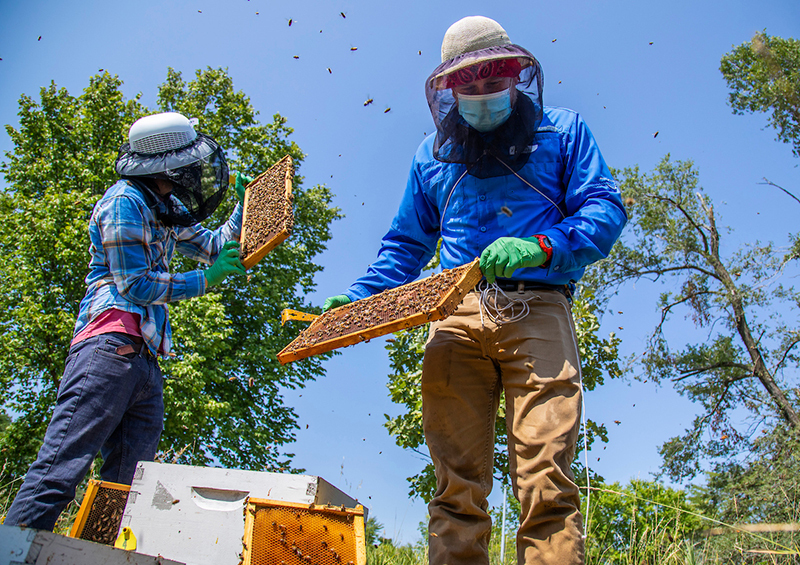
Photos by Christopher Gannon.
(Above) Bees circle in flight around a student (left) and ISU Extension and Outreach specialist Randall Cass as they examine hive frames Aug. 27 in the Bee Biology, Management and Beekeeping class, Entomology/Biology 358X. (Below) Associate professor of ecology, evolution and organismal biology Amy Toth (in pink jacket) instructs students. Four hives moved from the university's horticulture farm north of Ames to the prairie area north of the Environmental Health and Safety Services Building created a beekeeping classroom.
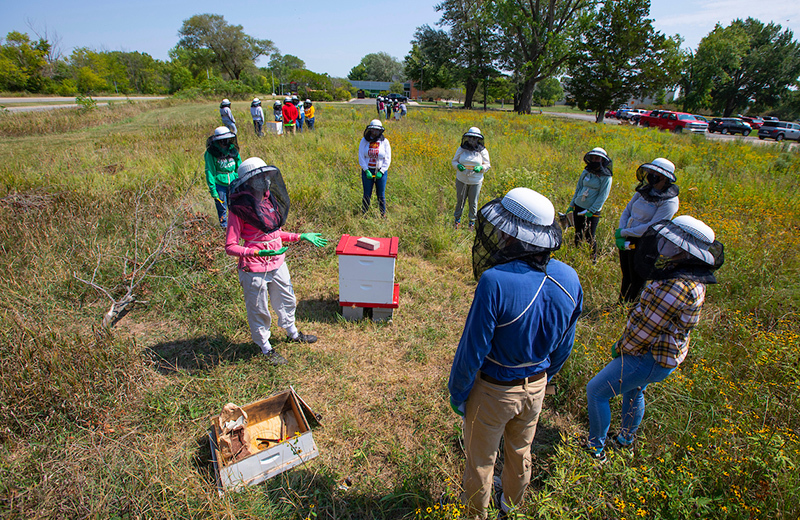
To adjust for COVID-19, some temporary flexibility for flex accounts
Contributing to a flexible spending account (FSA) for health care or the dependent care assistant program (DCAP) saves on taxes but takes careful planning since the payroll deductions to fund the accounts are selected once a year during open enrollment and unused funds can be lost. Because COVID-19 may have wreaked havoc on some personal budget projections, a temporary policy change will allow ISU employees to adjust FSA and DCAP contributions through December for pandemic-related reasons.
FSA items expanded
A reminder: A federal COVID-19 relief package in March expanded what purchases can be reimbursed with a flexible spending account to include a wide range of over-the-counter items such as menstrual care products and nonprescription medicines. The rule changes are retroactive to Jan. 1, 2020.
Employees choose the amount they want to set aside in FSA and DCAP accounts for the coming year during annual open enrollment held in November. Money contributed to the accounts is not subject to income or payroll taxes but can only be used for reimbursing eligible health care and dependent care expenses. Any funds left unused in a DCAP account are forfeited. Beginning with the 2020 plan year, up to $550 of unused FSA funds will carry over to the next year.
Typically, the amount employees contribute to these accounts can be modified during the plan year only after a change in family status. That includes a birth or death in the family, or changes in employment, marital status or child custody arrangements.
Effective now through the end of the 2020 calendar year, the university will allow employees to change FSA and DCAP contributions for reasons connected to COVID-19. To make a change, fill out a request form and explain the reason for the change. Email the request to benefits@iastate.edu.
Staff in the payroll, benefits and tax office will review requests and apply approved changes starting with the employee's next still-pending paycheck.
Annual amounts for FSA and DCAP can't decrease below what an employee has already contributed or the amount that has been distributed in claims. Increases are limited by the maximum annual amounts, which are $5,000 for dependent care and $2,700 for health care.
For questions related to this change or future tax law changes due to COVID-19, contact the payroll, benefits and tax office at fbac@iastate.edu.
Extension uses online options to reach audience
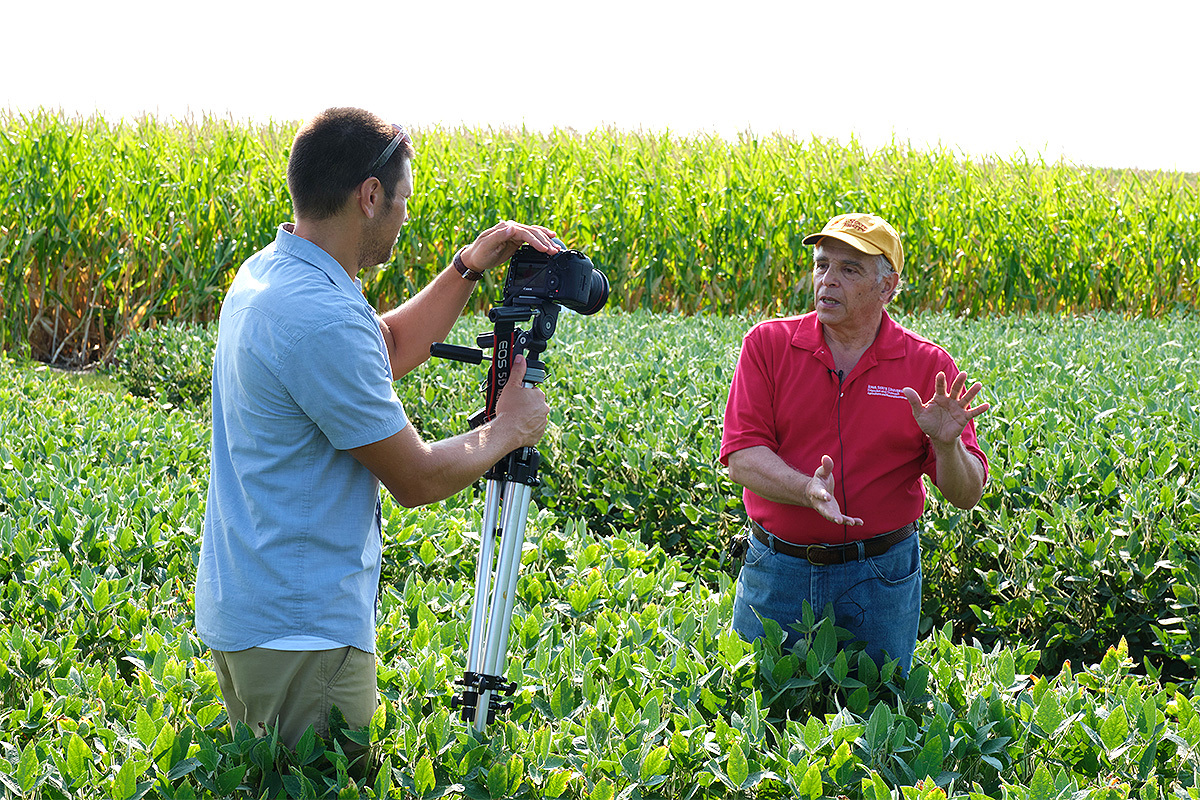
Videographer Brandon Kleinke and extension soil fertility specialist and professor of agronomy Antonio Mallarino record video at the Field Extension Education Laboratory (FEEL) west of Ames. Provided photo.
The coronavirus forced ISU Extension and Outreach to cancel its spring research farms field days, but the information is too important for those who make a living off the land to lose the fall event as well.
Extension responded by pulling together resources to have its first large-scale Research and Demonstration Farms Virtual Field Days this week. The event is spread over five days and is another example of efforts to help the agriculture community during a trying time.
It began Monday and concludes Friday, with a different topic presented by an Iowa State expert each day. The Zoom presentations are from 8-8:30 a.m., with the final 10 minutes reserved for questions and answers.
"Knowing how much people like to attend those research farm field days, we decided that if people couldn't come to us we would take the research and extension opportunities to them," said extension field agronomist Angie Rieck-Hinz.
In a normal year, attendance at each field day site ranges from 100-150 people, and as of last Friday, 341 individuals signed up for an online presentation with participants from 12 states and two countries.
"We are seeing people who wouldn't normally drive to Iowa, but they have good questions and good input," said Brent Pringnitz, extension coordinator for program services for ag and natural resources.
Putting it together
One of the biggest challenges of going online was traveling to each field site to record video for a presentation. Extension tapped into employees' talents to collect drone footage of the fields, edit and add data slides to aid presentations.
"From day one of the pandemic, it has been how fast can we get technology in people's hands," Pringnitz said. "Most of our specialists are good with cellphones, and they are already collecting video for social media, but we quickly realized we were going to need more technology."
Pringnitz worked to purchase high-quality microphones and cameras to make the project go.
Many extension staff leaned on Iowa Learning Farms' experience conducting 12 virtual field day offerings since April.
"Since March, we have been doing weekly webinars to share information and took the initiative on doing the virtual field day platforms to be the troubleshooters," said Liz Ripley, extension conservation and cover crop outreach specialist. "We do a follow-up with every live event with an online survey to get feedback from attendees."
Iowa Learning Farms wrote a blog to aid in each step of producing a virtual field day from content and technical production.
Important information
College of Agriculture and Life Sciences endowed dean Daniel Robison kicked off virtual field days Monday with an address.
"The design of field days is to highlight some of the long-term research we are doing, but we highlight a different outlying research farm in each piece," Rieck-Hinz said.
Information came from farms in Kanawha, Nashua and Sutherland in an effort to provide data from areas with different soils and climatic conditions.
Virtual here to stay
Extension conducted a well-received test run of virtual delivery in the spring at one farm. The ability to access research on demand is popular among the online viewers, Rieck-Hinz said. Most virtual offerings can be watched on the viewer's schedule through archives.
Extension's crop team is looking forward to returning to some semblance of normal, but will continue to offer virtual elements.
"We started moving a lot of our offerings online after spring break, and we had a crop scouting workshop online," Pringnitz said. "Normally, we would have 50-60 people at the workshop in May, and we had 750 people sign up for it from 20-some states."
A trying time
As farmers deal with a pandemic, the summer brought a significant drought and a derecho that flattened large amounts of the corn crop. Extension is helping individuals in nearly every aspect of their lives.
"Any way we can reach people -- from Webex, to Zoom, or even podcasts and teleconferences -- is important because people still are looking to us for some help," Rieck-Hinz said.
Extension has developed or updated several programs that assist with mental well-being during a difficult time for agriculture. Two key offerings are Stress on the Farm: Strategies that Help and Question. Persuade. Refer., which help farmers and their families deal with stress and uncertainty. The Stress on the Farm program is offered throughout September while Question. Persuade. Refer. is every Tuesday through October and focuses on suicide prevention.
"We started in April and already had over 500 participants from 14 states and Canada," extension behavioral health specialist David Brown said. "Farmers are at a pretty high risk for suicide, and then you add COVID, the drought and the derecho and it is about as much as anyone can handle."
Carillon model is on display in Sukup Hall
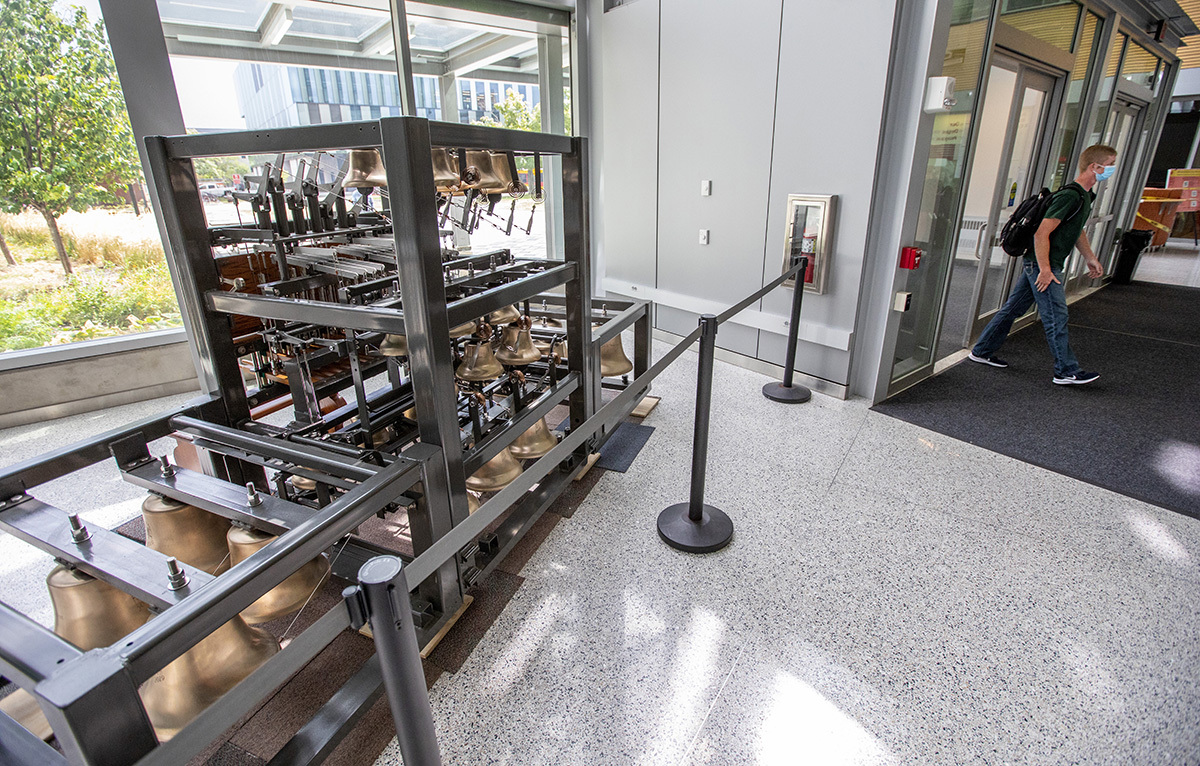
Photos by Christopher Gannon.
A travel-sized campanile and playable carillon has found a home in the Sukup Hall atrium. The 27-bell, 2,800-pound portable model will be on display during the fall semester as work on its finishing touches continues.
The one-fifth size model has been five years in the making. Senior design classes and cross-disciplinary collaboration helped design and create the model. This semester, mechanical engineering capstone students will focus on the final system and transportation design details. ISU Theatre design students will complete the removable campanile facade that attaches to a 21.5-foot scissor-lift bell tower.
The campanile/carillon model debuted with a performance at a celebration concert last fall in Stephens Auditorium. Post-COVID, it will be available to hit the road for special events, guest performances and educational outreach.
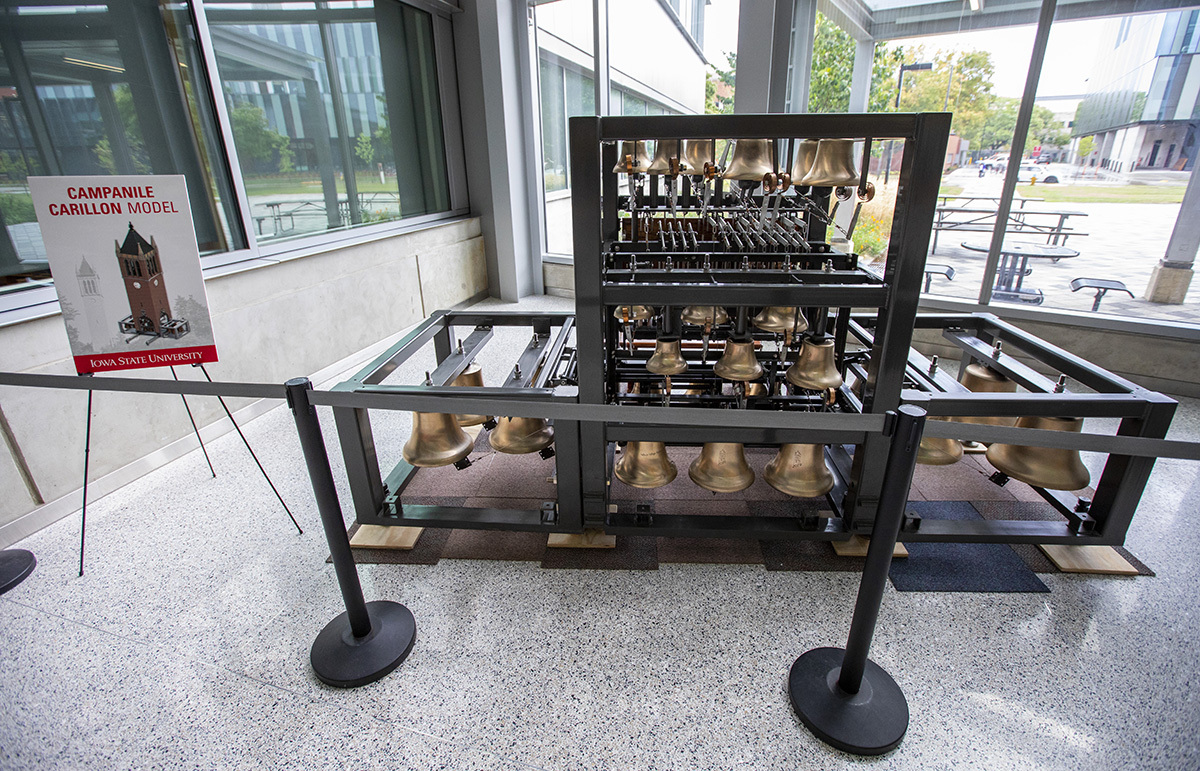
Innovation forum series launches next week
With the Student Innovation Center finally in use this fall, multiple innovation initiatives also are launching, said Karen Kerns, entrepreneur in residence.
One of those is a virtual innovators forum, tagged What IF, that opens Friday, Sept. 11 (noon-1:30 p.m.), and continues every week through the last Friday of the semester, Nov. 20. The moderated sessions will be hosted on Webex Events for the broader university community and registration is required.
Kerns said the series, for whom students are the intended primary audience, is designed to "give them access to something no one else has and accelerate their competitiveness."
President Wendy Wintersteen, Student Innovation Center director Jim Oliver and ISU Research Park president Rick Sanders will open the series Sept. 11. Other guests this fall include:
- Rowena Crosbie, president of Tero International, Des Moines, co-author of "Your Invisible Toolbox" and co-host of the YouTube TV show by the same name, Sept. 25
- Alumnus Dennis Muilenberg, owner, president and CEO of DAM CyFly Consulting, and former chairman, president and CEO of the Boeing Corp., Oct. 23
- Alumnus David Slump, president of Harman International, Stamford, Connecticut, a subsidiary of Samsung Electronics, Nov. 6
Kerns said they're conversations with leaders whose innovation experiences are vastly different in scope and scale. In addition to their personal stories, she said they've been asked to share their perspectives on the role of innovation in social and economic progress.
The series always was planned for online, Kerns said, because she wants to tap some of the world's leading innovators, regardless of where they are.
"Even before the pandemic, we weren't going to fly people here from Thailand. So, we needed to open a portal between our university and the world," she said. "This series is a permeable membrane between the two. It makes us Iowa State Universe instead of Iowa State University."
